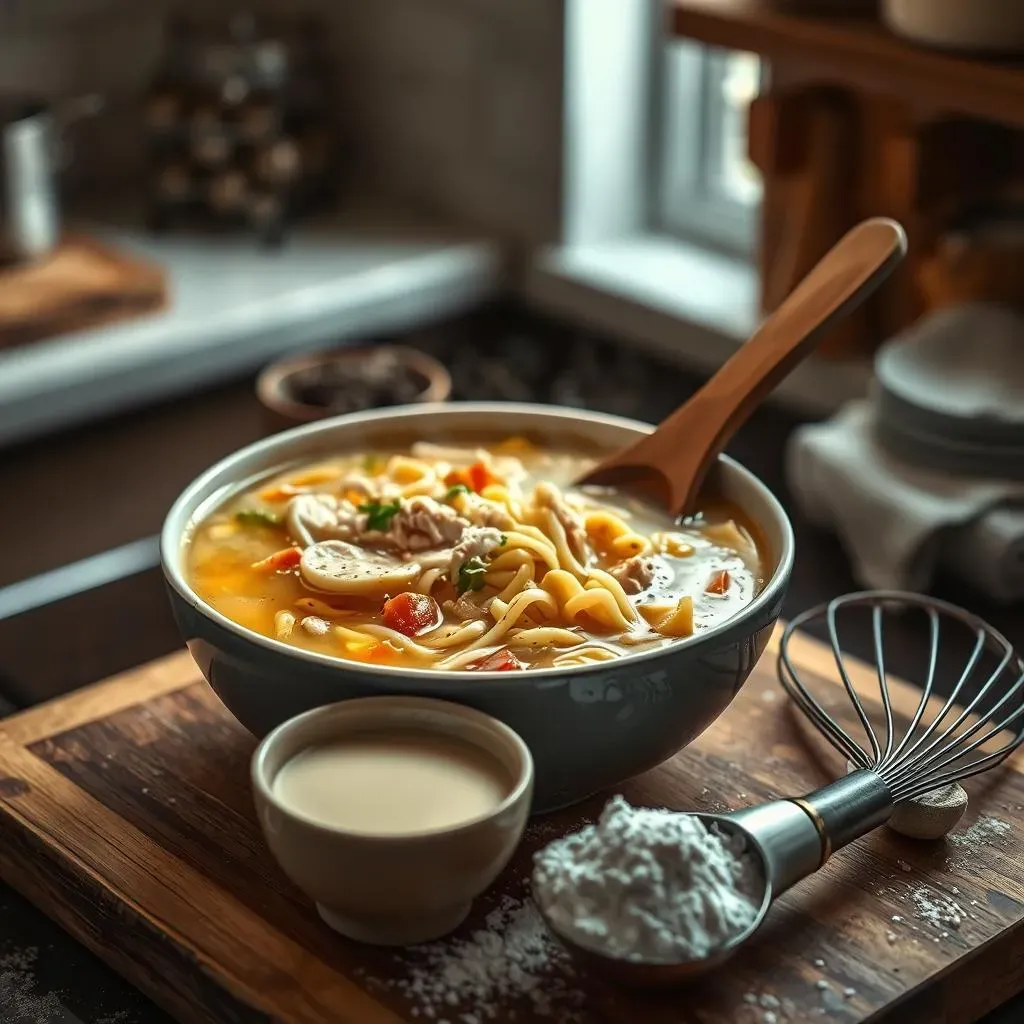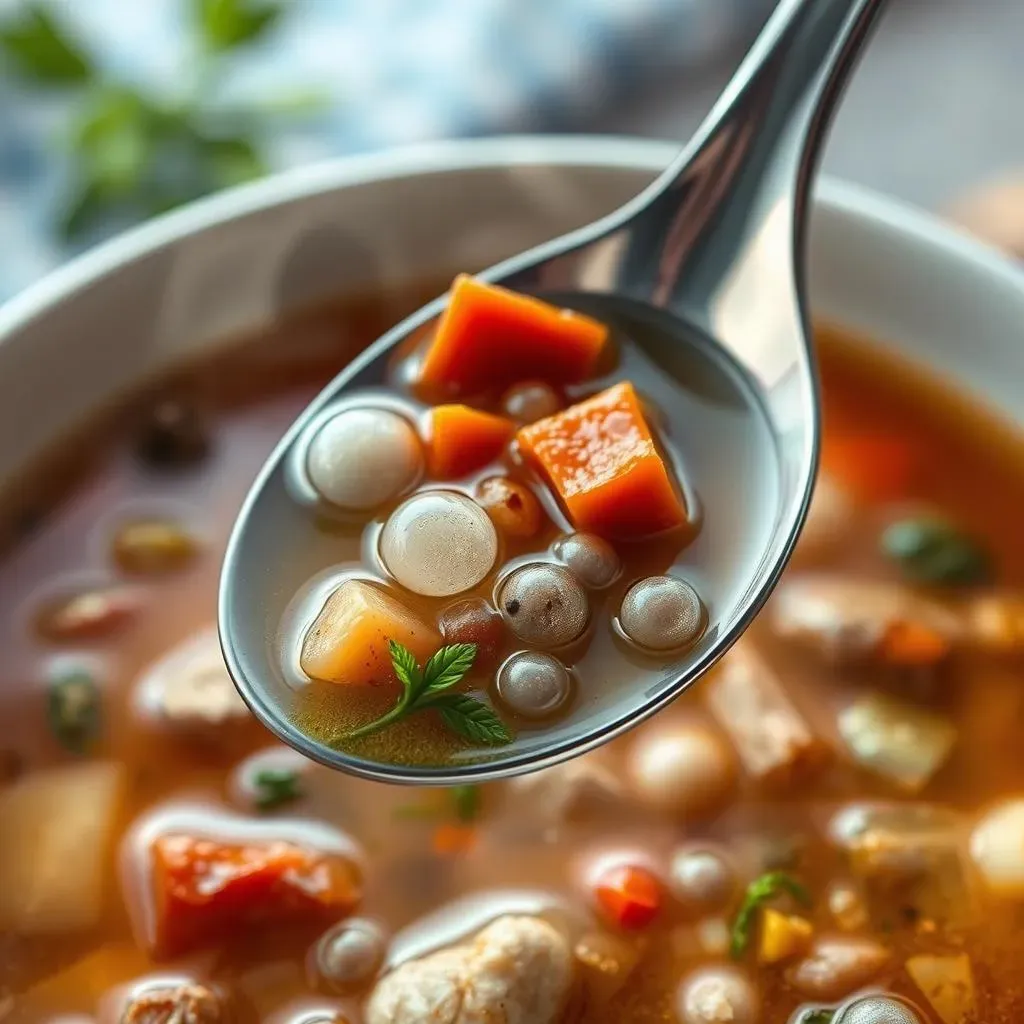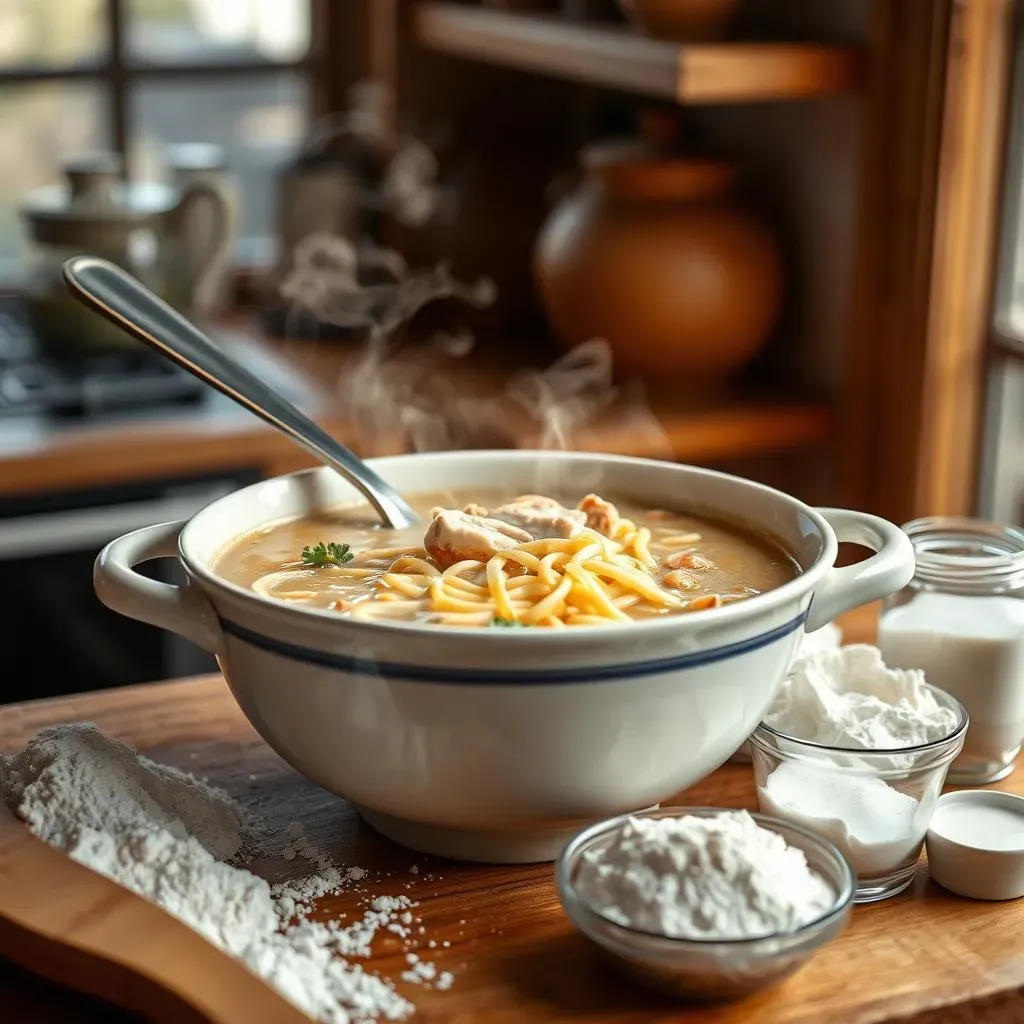Table of Contents
Ever slaved over a pot of chicken noodle soup, only to find it's as thin as dishwater? I get it. There's nothing sadder than a watery soup when you're craving a comforting, hearty meal. We've all been there, staring into a bowl of broth that just isn't cutting it. But don't despair, my friend, because today we're tackling the age-old question: how to thicken chicken noodle soup. This isn't some complicated science experiment; it's about understanding a few simple tricks that can turn your broth into a luscious, spoon-clinging masterpiece. We'll explore the best thickening agents, from pantry staples to unexpected heroes, and show you how to use them like a pro. So, grab your ladle, and let's get started on creating the perfect bowl of chicken noodle soup, thick enough to make you feel like you’re getting a warm hug from the inside out. We will cover stovetop methods, thickening agents, and some creative solutions to fix your soup.
Stovetop Secrets: How to Thicken Chicken Noodle Soup

Stovetop Secrets: How to Thicken Chicken Noodle Soup
The Roux Revolution
Alright, let's talk about the roux, my friend. It's a fancy French term for a simple mix of fat and flour, but it's a game-changer when it comes to thickening soups. Think of it as the foundation for a sturdy broth. You start by melting butter in your pot – not too hot, you don’t want it to burn – then whisk in flour until it forms a paste. Cook it for a minute or two, stirring constantly, until it smells a bit nutty. This step is crucial; it gets rid of that raw flour taste. Now, gradually whisk in your warm chicken broth, making sure there are no lumps. The roux will work its magic, thickening the soup as it simmers. It’s a classic technique for a reason; it’s reliable and gives a smooth, rich texture.
I remember the first time I tried a roux, I was so nervous. I thought it was some culinary sorcery, but honestly, it's just a matter of patience and a little whisking. I actually had a small mishap when I didn't cook the roux long enough and it tasted a bit floury. It was a good reminder to really let that nutty aroma develop. So, don't rush it and you'll be rewarded with a beautifully thickened soup. It’s all about that slow and steady simmer, letting the flavors meld and the roux do its thing.
Roux Type | Fat | Flour | Usage |
|---|---|---|---|
White Roux | Butter | All-purpose flour | Classic thickening for soups |
Blond Roux | Butter or oil | All-purpose flour | Adds a slightly nutty flavor |
Brown Roux | Butter or oil | All-purpose flour | Deep flavor, used in Cajun cuisine |
Starchy Solutions
If you're not feeling the roux, no worries! There are other ways to thicken your soup right on the stovetop. A simple cornstarch slurry is a great option. Mix a tablespoon or two of cornstarch with cold water until it's smooth, then stir it into your simmering soup. It thickens up pretty quickly so add it slowly while stirring, and remember, a little goes a long way! You'll see it transform your broth in a matter of minutes. It's a really effective and straightforward way to achieve that desired consistency without any fuss.
Another option is to use a potato. Adding a diced potato to your soup while it simmers not only adds some extra heartiness but also releases starch as it cooks, naturally thickening the broth. I've done this when I was out of cornstarch, and it worked like a charm. You can either mash some of the cooked potato against the side of the pot or remove some of it and mash it separately before returning it to the soup for a smoother finish. It's a great way to add a little something extra while also solving the thin soup problem, talk about a win-win!
The Science of Soup: Understanding Thickening Agents

The Science of Soup: Understanding Thickening Agents
Okay, so you've got the practical side down, but let's get a little nerdy for a moment and talk about the science behind why these thickening methods actually work. It's not just magic, you know! When you use a roux or cornstarch, you're essentially introducing starch molecules into your soup. These starch molecules are like tiny sponges, they absorb the liquid and swell up, making the broth thicker. Think of it like this: imagine a bunch of tiny balloons floating around in your soup, soaking up all the liquid. The more balloons (starch), the thicker the soup becomes. It's a pretty cool process when you think about it.
The type of starch you use will affect the final texture of your soup. Cornstarch is known for creating a glossy, almost translucent finish, while flour tends to give a more matte, opaque look. Potatoes, on the other hand, release a different kind of starch that results in a slightly creamier, more rustic feel. It’s all about experimenting and seeing what you prefer. I once tried using arrowroot powder as a thickener because I was curious, and it made my soup super silky, almost like a sauce. So, don't be afraid to play around with different options and see what works best for your taste and your soup.
Thickening Agent | Starch Type | Texture | Appearance |
|---|---|---|---|
Cornstarch | Corn Starch | Smooth, slightly gelatinous | Glossy, translucent |
Flour | Wheat Starch | Smooth, slightly thicker | Matte, opaque |
Potato | Potato Starch | Creamy, slightly grainy | Rustic, opaque |
Arrowroot Powder | Arrowroot Starch | Silky, smooth | Translucent |
Beyond the Basics: Creative Ways to Thicken Your Soup

Beyond the Basics: Creative Ways to Thicken Your Soup
Puree Power
Alright, let's get a little adventurous, shall we? Sometimes, the best way to thicken your chicken noodle soup isn't by adding anything extra, but by using what's already there. I'm talking about pureeing a portion of your soup. This is like a secret weapon for getting that creamy, thick texture without relying too heavily on starches or fats. Simply take out a couple of cups of your soup, veggies and all, and blend it until smooth. Then, pour it back into the pot and stir it in. The pureed veggies will act as a natural thickening agent, adding body and depth of flavor to your soup. It’s like giving your soup a makeover from the inside out.
I remember the first time I tried this trick. I was making a big batch of soup, and it was looking a bit sad and watery. I was about to reach for the cornstarch, but then I thought, "Why not blend it?" It was like a lightbulb moment! The soup transformed into a velvety, luscious concoction and it was so easy. It’s now one of my go-to methods when I want a thicker soup, with minimal effort. Plus, it’s a great way to use up any leftover veggies you might have lurking in your fridge.
The Creamy Dream
If you're looking for a richer, more decadent option, consider adding some dairy to your soup. A splash of heavy cream or half-and-half will not only thicken your soup but also add a luxurious, velvety texture. It's a great way to elevate your humble chicken noodle soup to something truly special. Just be sure to add the dairy towards the end of cooking, and don't let it boil, or it might curdle. You want to gently stir it in and let it warm through, creating a beautiful, creamy finish.
I once made a creamy chicken noodle soup for a friend who was feeling under the weather, and it was a total hit. The addition of cream made it so comforting and soothing, like a warm hug in a bowl. It's definitely a step up from the usual clear broth, but sometimes, a little indulgence is exactly what you need. I’ve even experimented with adding a bit of cream cheese for an extra tangy twist, and it was surprisingly delicious. So, don't be afraid to get creative and add your own touch to the creamy dream.
Dairy Option | Fat Content | Texture | Flavor |
|---|---|---|---|
Heavy Cream | High | Rich, velvety | Decadent, slightly sweet |
Half-and-Half | Medium | Smooth, creamy | Mild, balanced |
Cream Cheese | Medium-High | Thick, tangy | Rich, slightly sour |
Coconut Milk | Medium-High | Smooth, creamy | Subtly sweet, nutty |
Unexpected Additions
Now, let's talk about some unexpected ways to thicken your soup that you might not have considered. Mashed beans, like cannellini or white beans, can add a creamy texture and a boost of protein. Simply blend some cooked beans with a bit of the soup broth until smooth, then stir it back into the pot. It's a great way to sneak in some extra nutrients while also thickening the soup. It's like a secret ingredient that no one will suspect.
Another unexpected thickener is bread. Yes, you heard that right! A few slices of crustless bread, soaked in a bit of warm milk or broth and then blended, can work wonders for thickening your soup. It’s an old-school trick that's still surprisingly effective. The bread will break down and create a smooth, creamy texture. I once used stale bread to thicken a soup, and it was like magic. It was a thrifty and delicious way to use up what I had, and it made me appreciate the resourcefulness of traditional cooking techniques. So, don't underestimate the power of these unconventional thickeners; they might just surprise you!
